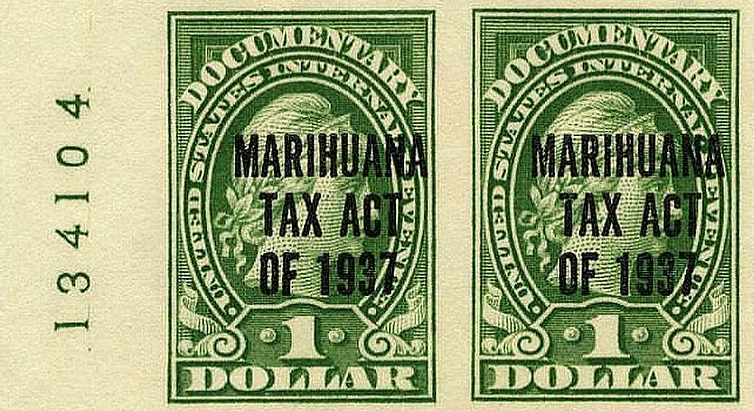This year is the 80th anniversary of the Marijuana Tax Act being signed into law by President Roosevelt and kicking off federal cannabis prohibition in the United States and ultimately the rest of the world.
This infamous unjust law was signed by the president on the 2nd of August 1937, and we are dedicating several posts here at greendorphin.com throughout the month of August to look at these early days in more details to find out how such devastating and unjust laws were made.
Cannabis oil was widely used as a medicine throughout the early twentieth century, however, smoking cannabis for relaxation and entertainment was not as well known. This form of consumption was popularized by the Mexican immigrants, that came to the US for farmhand and labor jobs throughout the growth years of the 1920’s.

The Mexican immigrants were welcomed by the employers, however, the working class saw them as cheaper labour and felt threatened by them.
They were also associated with deviant behaviour and crime. As the economy took a downturn in the 30’s, the Mexican immigrant laborers became scapegoats to express frustration resulting from the biggest economic downswing in the industrial age.
This is the time when the term ‘marijuana’ was adopted, and most people did not know that it had anything to do with cannabis and hemp.
By this time, the Federal Bureau of Narcotics was keen to be able to prohibit cannabis and commissioner Harry Anslinger was hoping that if marijuana was controlled by international treaties, it would be easy to ban it on the federal level.

Despite the hysteria from media reports and propaganda, Anslinger did not think that a bill banning cannabis would pass, due to the medical and industrial applications of cannabis at the time. However, if there were international treaties, just like the Migratory Bird Treaty Act of 1918, then it would be easy to introduce federal laws to ensure the US meets its obligations to the treaty, just like they did with banning hunting migratory birds.
Anslinger’s plan was to achieve a treaty for domestic cannabis control with 26 other nations at the Conference for the Suppression of Illicit Traffic in Dangerous Drugs, held in Geneva on the 26 June 1936.
This plan did not work, as the other countries involved in the conference voted the US proposal down.
At this point, it was clear that federal prohibition was not going to be helped by international treaties and something else was needed to be done.

That is when the Marijuana Transfer Tax idea came up, however, Anslinger had doubts about its prospects of success.
Nevertheless, they decided to go with the plan and present as strong of a case to Congress as possible. Anslinger was hoping that Congress would not know much about marijuana and was quoted saying “the only information they had was what we could give them in our hearings”.
This turned into H.R. 6385 act, that Anslinger drafted and Rep. Robert L. Doughton of North Carolina introduced on the 14th of April 1937.
The Act proposed to levy a tax of approximately one dollar on all buyers, sellers, importers, growers, physicians, veterinarians, and any other persons who deal with marijuana commercially, prescribe it professionally, or possess it.

The bill did pass on the back of the public hysteria fuelled by Reefer Madness and similar media coverage in newspapers and magazines, and the serious confusion about what ‘marihuana’ (as it was spelled at the time) was. Many people, including congressman voting on the bill, had no idea that ‘marihuana’ was actually cannabis.
President Roosevelt signed the bill on 2 August 1937 and the law officially took effect on 1 October 1937.
The medical professional community strongly opposed the prohibition of cannabis due to its unmatched therapeutic value and safety profile.
The motivation of Anslinger has been extensively questioned as, after 80 years of prohibition, more and more evidence surfaces to suggest that it was largely motivated by intentions to curb the hemp industry.
Anslinger was the son in-law of Andrew Mellon, who was the wealthiest man in the country at the time and was heavily invested in the new synthetic fibre, nylon that was being developed by the DuPont family.

Another enthusiast supporter of cannabis prohibition was media mogul William Randolph Hearst, who used his unmatched influence via his newspapers and magazines to spread fear about marijuana.
The true purpose of the act becomes questionable when we look at the penalty provision of the act:
“SEC. 12. Any person who is convicted of a violation of any provision of this Act shall be fined not more than $2,000 or imprisoned not more than five years, or both, in the discretion of the court.”
$2000 at the time was a huge amount of money and 5 years prison also sounds very excessive.
It is also noted that Anslinger drafted the bill in a way that granted him and the Bureau absolute administrative, regulatory and police powers to enforce the law.

“SEC. 14. The Secretary is authorized to make, prescribe, and publish all necessary rules and regulations for carrying out the provisions of this Act and to confer or impose any of the rights, privileges, powers, and duties conferred or imposed upon him by this Act upon such officers or employees of the Treasury Department as he shall designate or appoint.”
Looking back after 80 years and seeing the devastation, the human tragedy that this law has caused, it is very obvious that this nonsense law had nothing to do with public interest, but it was motivated by individual business interests.
Your thoughts/ views matter. Share it in the comments below.
- How to Use Waxmaid Honey Pen? - April 9, 2024
- How To Choose The Best Electric Dab Rig For Christmas - December 7, 2023
- Maintenance Matters: Keeping Your Glass Water Bong in Pristine Condition - October 9, 2023


